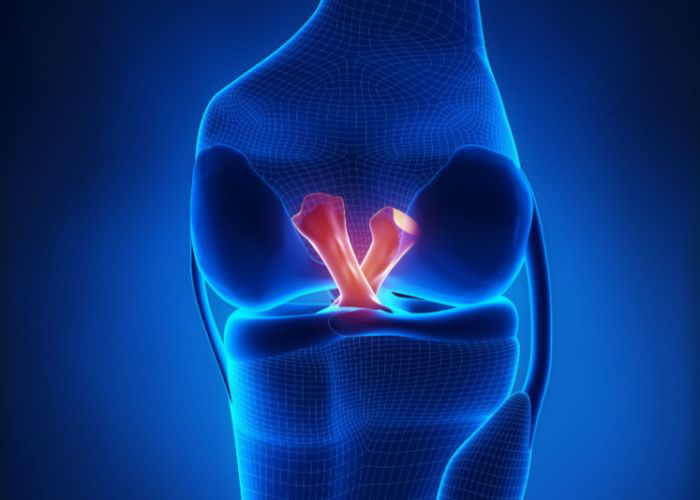What is a cruciate ligament injury?
The cruciate and collateral ligaments are two groups of elastic tissue bands that form part of the knee joint. The anterior and posterior cruciate ligaments originate at the posterior femur (thigh bone) and travel diagonally through the knee joint forming an “X” before attaching to the anterior tibia (shin bone). The function of these cruciate ligaments is to limit forward and backward movement of the tibia in relation to the femur. The anterior cruciate ligament (ACL), located in front of the posterior cruciate ligament, can sustain a tear within the ligament itself or from its attachment site when the ligament is stretched beyond its limits. The posterior cruciate ligament (PCL) is not as commonly injured as it is the strongest ligament within the knee joint. Yet, when a substantial force is imposed on the anterior knee, the PCL can be stretched or torn as well. A PCL injury most often affects athletes that participate in aggressive contact sports such as football or wrestling whereas athletes of all competitive levels and ages are susceptible to an ACL injury.

What is the treatment for a cruciate ligament injury, ACL and PCL?
Non-surgical therapies are a successful treatment option if a cruciate ligament injury does not result in knee instability, the patient does not use the anterior cruciate ligament (ACL) on a daily basis, or in the rare event of an isolated posterior cruciate ligament (PCL) injury. Non-surgical treatments may include avoiding weight-bearing and applying a knee brace. A combination of RICE (rest, ice, compression, and elevation) and non-steroidal anti-inflammatory medications (NSAIDs) may be used to control pain and decrease the inflammation associated with these injuries.
However, surgical intervention may be necessary if multiple structures within the knee are damaged, a patient sustains a severe or complete ACL tear, or if non-surgical therapy is unsuccessful. Reconstruction of the cruciate ligaments involves replacing the damaged ligament with a tendon graft, either from the patient (autograft) or donor tissue (allograft). A portion of the hamstring tendon, quadriceps tendon, or patellar tendon may be harvested for use as an autograft. Allografts can be considered as they can make the recovery period easier for the patient while also mitigating the risk of the ligament rupturing again. The tendon graft provides a surface for new tissue to grow and repair the damaged ligament. Dr. Ronak Mukesh Patel, orthopedic knee doctor, treats patients in Sugar Land, Pearland, and the Houston, Texas area who have experienced a cruciate ligament injury and are in need of surgical reconstruction.
How is cruciate ligament reconstruction performed?
Cruciate ligament reconstruction is typically completed as an outpatient procedure. An examination under anesthesia is performed prior to operating on the knee to verify the torn ligaments and assess the integrity of the other knee ligaments. The chosen tendon graft is either harvested from the patient or thawed from the donor. To begin the reconstructive procedure, Dr. Patel creates several small incisions around the knee joint. A small camera (arthroscope) is inserted through a portal and the images are transmitted to a screen for Dr. Patel to methodically examine the bones, ligaments, and cartilage of the knee joint. A sterile solution is continuously circulated through the knee joint to enhance the visualization of these structures. Specialized surgical instruments are then introduced to excise and remove the damaged ligament fragments and complete any other necessary repairs.
Reconstruction of the anterior cruciate ligament (ACL) is accomplished by creating a bone tunnel through the distal femur and proximal tibia. The tendon graft is passed through these holes and fastened by special surgical anchors or interference screws that are secured within the bone. Posterior cruciate ligament (PCL) reconstruction is similar with bone tunnels in the anatomic location of the PCL. Situating the tendon grafts as close to the native tissue as possible is important for a more successful recovery. After the necessary revisions are completed, the new ligament is evaluated for good tension and stability, and the range of motion of the knee is assessed. The arthroscope and surgical instruments are then removed and the incisions are closed with sutures or steri-strips.
What is the recovery period like after cruciate ligament, ACL or PCL reconstruction?
The recovery period following cruciate ligament reconstruction is largely dependent upon the specific surgical technique performed, the ligament that was repaired, and the type of tendon graft used by Dr. Patel. Although arthroscopic surgical procedures typically result in shorter recovery periods, the bones, tendons, and ligaments still take the same amount of time to heal. The recovery period can also be affected by the patient’s willingness to comply with the post-operative care instructions provided by Dr. Patel. Most patients can expect a return to their normal daily activities in approximately 6 to 9 months. Patients in the Sugar Land, Pearland, and the Houston, Texas area can anticipate the following:
- The knee joint will be immobilized with a brace or other device immediately following surgery.
- The pain and inflammation experienced during the recovery process can be managed with a combination of RICE (rest, ice, compression, elevation) and non-steroidal anti-inflammatory medications (NSAIDs). If necessary, Dr. Patel can prescribe stronger pain medication to be taken as directed.
- The key to a successful recovery following cruciate ligament reconstruction is the active participation and completion of the physical rehabilitation program designed by Dr. Patel. This physical therapy program will be focused on restoring strength, mobility, and range of motion to the knee.
ACL and PCL – Complex Knee Surgeon

The ACL (anterior cruciate ligament) and the PCL (posterior cruciate ligament form an “X” within the knee and are responsible for knee stability. An injury to one or both of these ligaments usually requires surgery to repair or reconstruct the ligaments. Complex knee surgeon, Doctor Ronak Mukesh Patel, provides diagnosis as well as the latest and best surgical options for patients in Houston, Sugar Land, and Pearland, TX who have sustained an injury to their ACL or PCL in the knee. Contact Dr. Patel’s team today!








